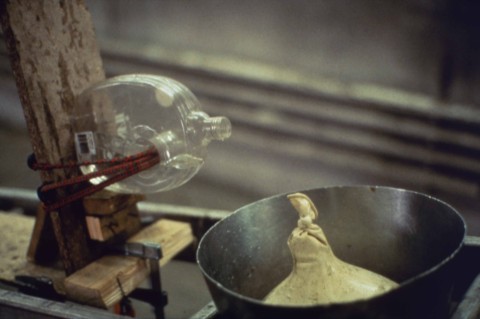Considered one of the most enduring partnerships in contemporary art, the Swiss artist duo Peter Fischl and David Weiss met in 1978, a year prior to creating Wurstserie [Sausage Series], their first joint venture. A collection of ten photographs that depict everyday scenes, the imagery in Wurstserie is cleverly portrayed with slices of cold cut meats and pieces of sausage. Subsequent work by the duo would continue in a similar whimsical vein until Weiss’s passing from cancer in 2012.
Between 1984 and 1986, Fischl & Weiss made Equilibres (A Quiet Afternoon), a photographic series of precariously positioned household objects, such as a tilted bottle balancing a slanted piece of wood that holds a can and wooden cylinders on either end. One easily can imagine the crashes that took place seconds after the shutters of the camera lens. Inspired by those collapsing structures, Fischli & Weiss developed a 100-foot-long Rube Goldberg-esque construction, also made from simple everyday objects, for The Way Things Go (1987).
The video begins with a close-up shot of a spinning black trash bag, which pulls out to reveal the bag suspended over a tire that it knocks and rolls to trigger a half-hour chain reaction of wheels spinning, tables sliding, bottles spilling, and balls dropping. The DIY aesthetic of the piece—a wavering handheld camera following the action in a vacant warehouse—belies the awe it inspires in viewers, as chairs, candles, and balloons operate in abnormal ways and seemingly on their own.
Fischli & Weiss spent more than a year perfecting the installation, and the video was shot over a two-year period. However, the painstaking efforts of the artist duo is nowhere to be seen in the final work. There is no human presence, and further, the title gives agency to the objects. The objects, or “things,” are the actors—they are animate and appear to take on lives of their own, responding to each other in their own contained ecosystem. Without human decision or direction, they deviate from the functions with which we are familiar. We thus are made privy to the way these things will go when left to their own devices.
Is the work post-apocalyptic? Are we watching objects survive in a world without humans that lacks technology, where only scattered elements of our society remain? Their activities indeed leave destruction in their wake, as each segment of the chain involves a fall, spill, collapse, or explosion until the end, when it all literally goes up in smoke.
And, at the end, their activities accomplish nothing. There is no apparent goal, but one can ask if there should be one. Must the objects’ actions result in some sort of progress or accomplish a task? Perhaps we simply can appreciate the journey to nowhere and enjoy the wonder and pleasure it brings. Despite the idea of apocalyptic preceding events, the domino effect is creative, playful, and always unexpected.
Surprising in many ways, The Ways Things Go also is nonetheless rooted in an art historical foundation. It recalls the curious assemblage and readymade art of Duchamp and the experimental destructive Dada machines of Jean Tinguely. The work also aligns with the strategic spontaneity of 1960s happenings and process art of the 1970s, in which the making of the work is made apparent in its presentation and takes precedence in its interpretation. Conversely, The Way Things Go can be seen as a precursor to later trends, such as the accumulation of seemingly disparate objects in scatter art of the 1990s.
After its debut at Documenta 8, The Way Things Go became an instant hit, garnering awards at the Berlin, Sydney, Hong Kong, and San Francisco film festivals, due to its winning combination of suspense and slapstick. More than fifteen years later, the video caught the attention of the car manufacturer Honda, which appropriated it in the production of its popular 2003 “Cog” commercial. And The Way Things Go continues to remain popular today, with presentations at LUMA, Arles, and MOCA, Los Angeles in recent years. It also is included in the collections of the Museum of Modern Art and Guggenheim Museum, thus supporting the assertion of The New York Times that it is indeed “a masterpiece.” —Kanitra Fletcher

